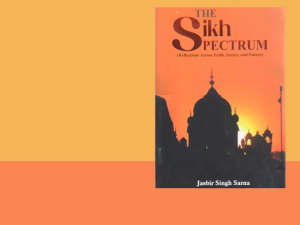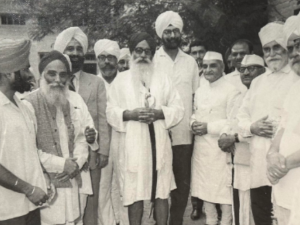What is Reincarnation
Sikh theology differs in defining reincarnation. The ideas of reincarnation are many and as old as human civilization. Their descriptions are found from the last centuries of the 1st millennium BCE. However, the ideas remain ideas only, and have never reached any logical or precise description.
Descriptions of reincarnation differ from one faith to another. The most popular ones describe reincarnation as the repeated rebirth of the soul into successive human or animal bodies until spiritual liberation is attained through ethical living and a variety of meditative, yogic, or other religious practices. It may even be the decision of a prophet on the day of judgment.
The Logic Behind Reincarnation
At the outset, the present descriptions of reincarnation defy modern logic, and most religious leaders shrewdly shy away from offering any reasonable explanation. Vedic traditions consider the release from the cycle of rebirths as the ultimate spiritual goal and call the liberation by terms such as moksha, nirvana, mukti, and kaivalya. Abrahamic theology suggests that the entities that die wait in hell or heaven until the new life becomes available and granted.
Here, I wish to put together the view expressed by the authors of the Guru Granth, the sacred scripture presently in the custodianship of the Sikhs.
Who Goes Through Reincarnations?
Siddhas, the scholars of the ancient Hindu religions asked Guru Nanak about reincarnation as one of their questions during the interfaith dialogue Guru Nanak had initiated with them. The Guru’s reply is archived in the following verses of the Guru Granth (SGGS) on page 939.
Siddhas asked:
ਕਵਨੁ ਸੁ ਆਵੈ ਕਵਨੁ ਸੁ ਜਾਇ ॥ Who comes and who goes into life cycles?
Guru Nanak responded,
ਮਨਮੁਖਿ ਬਿਨਸੈ ਆਵੈ ਜਾਇ ॥ “Manmukh”- (mind-orientations) die
and the same are reborn.
Then what is “Manmukh”?
Manmukh, Memes, and Mind Animals
Manmukh is a cluster of entities that are subject to reincarnations, besides its many roles during any human lifespan. These entities take instructions from m’n which as a bunch of memons is continuously formatting the human mind. Each memon is a cluster of memes. A meme is an element of a culture or a system of human behaviors, that may pass from one individual to another by nongenetic means. They are sensory inputs originating from a wide range of complex phenomena in the human environment – language, art, scientific thinking, political behavior, productive work, religion, philosophical discourse, even history itself. They are imitations or bombardments of sensory data originating continuously in the cultural environment and, in turn, continuously forming memons that become the precursors of m’n or mind. The instructions from m’n become the architect of our intellectual faculties. The mental faculties similarly impacted work their way into our consciousness to render it manmukh.
What is born and what dies, according to Guru Nanak’s response to a question from Siddhas is the manmukh. Manmukh minds go through unending reincarnations according to the Sikh theology detailed in the Guru Granth. A couple of its illustrations are quoted below.
ਅੰਧੁਲੈ ਨਾਮੁ ਵਿਸਾਰਿਆ ਮਨਮੁਖਿ ਅੰਧ ਗੁਬਾਰੁ ॥ ਆਵਣੁ ਜਾਣੁ ਨ ਚੁਕਈ ਮਰਿ ਜਨਮੈ ਹੋਇ ਖੁਆਰੁ ॥
SGGS, 19.
The blind forgot the Creator and became mind oriented, manmukh, to dwell in utter darkness. Then, Manmukh experiences continual reincarnations i.e. continued coming and going that do not end; through death and rebirth, one is wasting away.
Here, we may realize that the manmukh intellect is often deceitful. It makes us feel good when we do things that it approves. It primes us for actions that fall within the slavery of its precepts. It blurs the boundaries between pleasure and illusion. We begin to interpret our brain’s chemical impulses resulting from the dictates of secular cultures as actual sources of pleasures and pains. Our bodies become servants to their whims, thus acting like numerous varieties of animals. The “animals” thus born in one’s mind are subject to multiple transmigration or reincarnations.
Illustrations of Reincarnations
The Sikh scriptures provide many illustrations of the above-described transmigrations or reincarnations of the human mind. Any person may experience them within a human lifespan. The Guru Granth even spells out some example of animal-like rebirths suffered by those who are devoid of Guru given mantra of the right path.
ਗੁਰ ਮੰਤ੍ਰ ਹੀਣਸ੍ਯ੍ਯ ਜੋ ਪ੍ਰਾਣੀ ਧ੍ਰਿਗੰਤ ਜਨਮ ਭ੍ਰਸਟਣਹ ॥
ਕੂਕਰਹ ਸੂਕਰਹ ਗਰਧਭਹ ਕਾਕਹ ਸਰਪਨਹ ਤੁਲਿ ਖਲਹ – SGGS, p. 1356
Those mortals who are devoid of Guru’s teachings live cursed and contaminated lives. Their life is often that of a dog, a pig, a jackass, a crow, and a snake.
The Guru Granth says that excessive desires also lead to similar reincarnations of mind that leads to life cycles like those in the hell.
ਹੇ ਕਾਮੰ ਨਰਕ ਬਿਸ੍ਰਾਮੰ ਬਹੁ ਜੋਨੀ ਭ੍ਰਮਾਵਣਹ ॥ SGGS, p. 1358
O excessive desires, you lead the mortals to wander in reincarnations of countless species, thereby, driving them to live in the hell.
Similarly, according to another verse, narcissist’s mind (Manmukh) is said to lead the human beings to the cycles of reincarnations.
ਹਉਮੈ ਵਿਚਿ ਜਗੁ ਬਿਨਸਦਾ ਮਰਿ ਜੰਮੈ ਆਵੈ ਜਾਇ ॥ SGGS, p. 33.
The humanity is dying under the influence of narcissism and continually rotating in many reincarnations of coming and going (births and deaths).
ਹਉਮੈ ਮਾਇਆ ਰੋਗਿ ਵਿਆਪੇ ਮਰਿ ਜਨਮਹਿ ਦੁਖੁ ਹੋਈ ਰਾਮ ॥ SGGS, p. 768
Those who are afflicted with the diseases of narcissism and live under the illusion of Maya, they all suffer from the pains of deaths and rebirths (reincarnations).
Another verse,
ਹਉਮੈ ਵਿਚਿ ਜਗੁ ਬਿਨਸਦਾ ਮਰਿ ਜੰਮੈ ਆਵੈ ਜਾਇ ॥ SGGS, p. 33
Engrossed in narcissism, the world perishes. It dies and is reborn; it continues coming and going in reincarnation.
Likewise, those attached to the love of duality suffer unpleasant reincarnations.
ਧ੍ਰਿਗੁ ਖਾਣਾ ਧ੍ਰਿਗੁ ਪੈਨ੍ਹ੍ਹਣਾ ਜਿਨ੍ਹ੍ਹਾ ਦੂਜੈ ਭਾਇ ਪਿਆਰੁ ॥
ਬਿਸਟਾ ਕੇ ਕੀੜੇ ਬਿਸਟਾ ਰਾਤੇ ਮਰਿ ਜੰਮਹਿ ਹੋਹਿ ਖੁਆਰੁ ॥੫॥ SGGS, 116
Cursed is the food, and cursed are the clothes, of those who are attached to the love of duality. They are like maggots living in manure and sinking into a slurry of manure. There only they die and take births. Thus, they are wasted away to ruin.
Salvation from the Cycles of Reincarnation
Should people of this world not learn the right path of successful living, and not realize the right way, they will continue to exist in the human bodies, but, in reality, they will be as dead human. In fact, they will be condemned to thousands of lives of reincarnations that will doom them to wrecks.
ਅੰਤਰਿ ਗਿਆਨੁ ਨ ਆਇਓ ਮਿਰਤਕੁ ਹੈ ਸੰਸਾਰਿ ॥ ਲਖ ਚਉਰਾਸੀਹ ਫੇਰੁ ਪਇਆ ਮਰਿ ਜੰਮੈ ਹੋਇ ਖੁਆਰੁ ॥ SGGS, p. 88
Those who do not acquire spiritual wisdom into their hearts; they are like dead bodies in the world. They go through the cycle of 8.4 million (meaning countless) reincarnations which devastate them through the punishments caused by deaths and rebirths.
Freedom from Reincarnation is the Goal
According to the path of Sikhi, freedom from reincarnations is the Goal of Human Life. But how? The Guru Granth suggest a few ways.
First, one must come to realize that just by going through reincarnations one never reaches any permanent abode of peace. However, such a life may be achieved through the path shown by Guru, the one with the ability to lighten up the trail hitherto covered by darkness.
ਅਨਿਕ ਜਨਮ ਭ੍ਰਮਿ ਥਿਤਿ ਨਹੀ ਪਾਈ ॥
ਕਰਉ ਸੇਵਾ ਗੁਰਲਾਗਉ ਚਰਨ ਗੋਵਿੰਦ ਜੀ ਕਾ ਮਾਰਗੁ ਦੇਹੁ ਜੀ ਬਤਾਈ ॥
SGGS, p. 687
I failed to achieve a permanent abode of peace just by going through countless reincarnations. Now I serve the causes of the Guru and seek Guru’s teachings so that Guru may teach me the way to the salvation.
According to Gurmat (path of the Guru or Divine Wisdom), first, one may seek the company of those who have achieved the salvation from the reincarnations.
ਸਫਲ ਸਫਲ ਭਈ ਸਫਲ ਜਾਤ੍ਰਾ ॥ ਆਵਣ ਜਾਣ ਰਹੇ ਮਿਲੇ ਸਾਧਾ ॥ SGGS, p. 686
The journey of this life is successful only when reincarnations of human mind end, for which one may seek the company of those who have achieved success in conquering their m’n (mind of Manmukh).
ਨਾਨਕ ਸਤਿਗੁਰਿ ਭੇਟਿਐ ਪੂਰੀ ਹੋਵੈ ਜੁਗਤਿ ॥
ਹਸੰਦਿਆ ਖੇਲੰਦਿਆ ਪੈਨੰਦਿਆ ਖਾਵੰਦਿਆ ਵਿਚੇ ਹੋਵੈ ਮੁਕਤਿ -SGGS, p. 522
Says Nanak, meeting the True Guru, one comes to know a Perfect Way. While laughing, playing, dressing and eating, the follower is liberated.
A scholar by the name of Tal paid a visit to Guru Arjan, the compiler-editor of the Guru Granth. When in the company of the Guru, he composed the following verse.
ਸੁ ਕਹੁ ਟਲ ਗੁਰੁ ਸੇਵੀਐ ਅਹਿਨਿਸਿ ਸਹਜਿ ਸੁਭਾਇ ॥
ਦਰਸਨਿ ਪਰਸਿਐ ਗੁਰੂ ਕੈ ਜਨਮ ਮਰਣ ਦੁਖੁ ਜਾਇ ॥ - SGGS, 1392.
So, speaks TAL the poet: serve the Guru, day and night, with intuitive love and affection. Contemplating upon the philosophy of the Guru, the pains of death and rebirth are taken away.
Conclusion
According to Gurmat (path of the Guru). The reincarnations apply to the birth and deaths of the human mind, m’n, and not the human body. m’n is described succinctly as a storehouse of the many clusters of memes. Memes are mental storehouses of ideas formed from units of cultural inputs. They are capable of self-replication and cross meme transmission, thus creating the seat of reincarnations.
We erroneously learn to listen to our inner voices to guide our actions. The inner voices come from m’n.
ਮਨ ਕਾ ਕਹਿਆ ਮਨਸਾ ਕਰੈ ॥ ਇਹੁ ਮਨੁ ਪੁੰਨੁ ਪਾਪੁ ਉਚਰੈ ॥
– SGGS, p. 832
People do what their human conscience (m’n) commands, thus it is their human conscience that defines sins and virtues.
This paper described reincarnations as various forms of m’n that are continually taking new births. Only the company of those who have conquered the m’n may show the path of ultimate realization and end the pains of reincarnations.
ਸਾਧਸੰਗਿ ਜਪਿ ਨਿਸੰਗ ਜਮਕਾਲੁ ਤਿਸੁ ਨ ਖਾਵਨੋ ॥ AGGS, p. 1323.
Whoever chants sacred hymns and meditates on Naam in the Saadh Sangat,
the seekers’ gatherings, shall undoubtedly escape from consumption
by the Messenger of Death.





